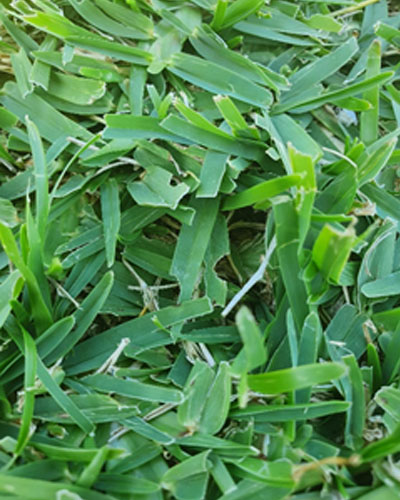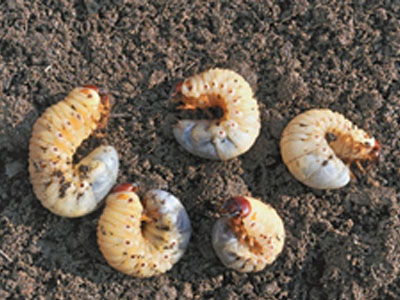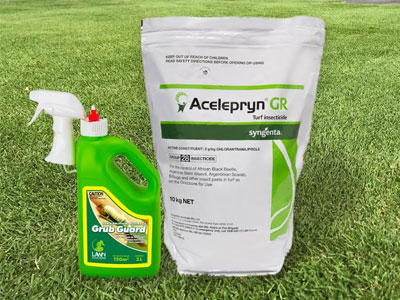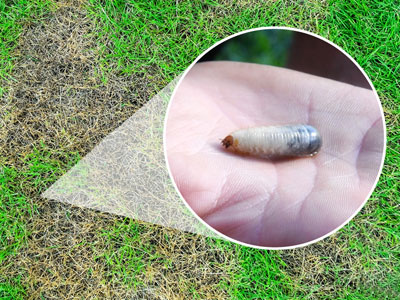Lawn grubs are a real concern in South East Queensland. Traditionally, we see more lawn grub activity during the warmer months of November through to May and the greenest, healthiest lawns are the ones most likely to be attacked. Couch lawns, and ‘Sir Walter’ lawns less than 12 months old, as well as any lawn that has been fertilised within the last 2 months are the most susceptible to the threat of lawn grubs. We normally find however, that damage is minimal to Sir Walter and the lawn recovers fairly quickly.
What are Lawn Grubs/Army Worms?
In Queensland there are a few different types of pests that we all commonly refer to as the collective term ‘lawn grub’. It is commonly used to describe Army Worms and White Curl Grubs, both of which cause similar issues for your otherwise healthy lawn.
How to check for lawn grubs
If you have concerns, there are a few ways to check for lawn grubs:


White Curl Grub
Root feeding grubs are sometimes known as white curl grub, scarab beetle larvae, lawn beetle larvae or cockchafer. These are the common names for the juvenile stage of lawn beetle that feed on the lawn roots. White curl grub, however, is sometimes incorrectly referred to as a ‘witchetty grub’.
White curl grubs are a serious lawn pest and the signs of infestation are easily confused with other pests, diseases and disorders in turf. White curl grub will eat away at the root system of the turf causing yellowing and browning with the infestation ultimately resulting in the death of the lawn. With a serious infestation you are often able to roll the turf up as the root system will be completely destroyed! Every lawn in Queensland at some time will have some white curl grub present and an infestation is generally regarded as a problem when there are 25 or more grubs existing per square metre. If less, a normal and healthy lawn with seasonal growth will sustain any damage caused. However, other external influences may likely exacerbate the problem, such as heat or drought conditions.
Army Worm
Army worms are leaf eating caterpillars, the larvae of an adult moth. The adult army worm takes the form of a greyish-brown moth with a wing span of 35 to 40 mm. The worms themselves can be green, brownish green or black in appearance and sometimes even have a striped appearance. They hatch after 5 to 7 days and that’s when the major damage to your lawn is done.
They often start closest to the house near external light sources, which attract the adult moth. The damage from army worm differs slightly from the white curl grub, as they work similar to that of other caterpillars and eat the leaves of the turf. It is often seen as a clear line of dying grass, or brown and straw like patches in your lawn, or the leaves of the grass runners in your lawn disappear.
Once the worms have exhausted the food supply, they all gather in big groups and move on; a bit like an army on the march.


Lawn Grub Treatment
Lawn Solutions Australia’s Grub Guard is a new treatment product now available. It is completely environmentally friendly and safe to use. All gardeners need to control lawn grubs to reduce the detrimental effects they have on lawns and plants. Grub Guard kills aphids, bugs, caterpillars, mole crickets and many other pests … and it’s the only product currently on the market that kills lawn grub larva, and that can be used as a preventative treatment against lawn grubs. It features an easy spray applicator and the 2L pack we supply is enough to treat 150m2.
It contains the active ingredient Esfenvelerate, a broad-spectrum insecticide toxic to most insects, but less toxic to birds and of minimal toxicity to mammals. It’s safer to use than any other pest control product. In addition, it also prevents some damage to your foliage as it can be applied when the moths appear prior to the actual attack.
Acelepryn GR is one of the best products on the market, it was only available commercially up until this year, however it is now available domestically. It is expensive, but one of the most effective and safest products on the market.
It’s a preventive treatment and depending on application rates can last up to 6 months and it will take out a large range of pests in lawns including African Black Beetle, Argentinian Scarab, Billbugs and several species of caterpillars including Cutworm and Lawn Armyworm. Acelepryn now comes in granular form which makes it even easier to apply. A 10kg bag will cover up to 1000m2 and last up to 6 months.
At Daleys Turf we spray all turf leaving our farm with Acelepryn from November through to March, subject to the lawn grub season. This gives our customers piece of mind for 6-10 weeks while their new lawn is being established.
The ‘organic’ approach to getting rid of lawn grubs
A natural, organic approach generally relies upon early mornings, a good lawn care regime and carnivorous birds.
Please be aware though, eradicating lawn grubs does not mean that they won’t return. If you still have healthy lush patches of lawn, you are still at risk from lawn grubs and need to keep your eye out for further attacks. To restore your lawn prior to Winter, it is best to fertilise to promote new leaf growth.

Lawn Grub Prevention
The lawn grubs have impeccable taste and won’t settle for a lawn already struggling – the house with the nicest lawn is generally the one that gets hit the hardest. Prevention is the key to avoid lawn grub, but most commercially available pesticides are designed to treat an existing problem of lawn grub, rather than prevent it from occurring. Some of the granular mixes can be present for a short time after application and so will inadvertently prevent lawn grubs developing. The place to start in terms of prevention is ensuring your home, eaves, shed, and fences are all free of moth nests. These range in appearance but most look like little cotton cocoons. The best way to get rid of them is with a hose and a broom. It’s not a guarantee, but at least you are limiting the amount of moth activity around your property and hopefully the number that will have the opportunity to turn into lawn grubs.
Also, be careful when you fertilise as lawn grubs will see this as an invitation to move in and make themselves at home. This is especially important around January and February while the climate is typically very warm and wet. Lawns that require little in the way of fertiliser – such Sir Walter DNA Certified buffalo will be much less appealing to grubs.

This Post Has 0 Comments